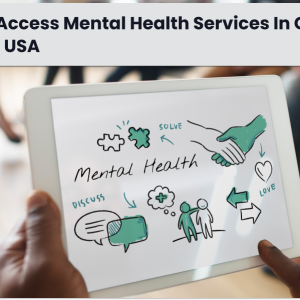
Struggling to Access Mental Health Care? Here’s How to Get Help
For as long as anyone could remember, seeking help for mental health in North America came with its own set of challenges. There were long waiting lists, limited options for therapy in remote areas, and most importantly, the lingering stigma that still surrounds mental health care. People who needed help often found themselves making excuses, hesitating, and sometimes giving up altogether. But the story began to change when telehealth entered the scene.
A Struggle to Get Help
Meet Kiya. Kiya lives in a small town in rural Canada. For years, she struggled with anxiety and depression, but the nearest therapist was over two hours away. Every time she thought about making the long drive, she felt overwhelmed, like her mental health wasn’t enough of a priority to justify the time and energy required. And when she did finally make an appointment, it often felt like she was too far behind to catch up.
kiya’s story is not unique. Across North America, people like her are faced with similar obstacles, often feeling isolated and unsure of where to turn for help. Traditional therapy has long been hindered by geographic barriers, high costs, and long wait times.
A New Hope: Telehealth
Then one day, kiya came across an ad for an online therapy platform. “Telehealth” was a term she had heard of but never thought much about. The idea of having therapy sessions from the comfort of her home seemed like a dream, but could it really work? She was skeptical, but curious.
kiya signed up for a session, and what followed changed her life.
The therapist appeared on her screen, welcoming her into a space that felt safe, personal, and private. No travel, no waiting in a cold, sterile office. Just an opportunity to talk—freely, honestly, and without judgment.
And it wasn’t just the convenience of being able to attend therapy from home that made the difference for kiya—it was the accessibility. Telehealth platforms like this one, whether in Canada with services like Inkblot Therapy or in the U.S. with BetterHelp, have been able to bridge the gap between people like kiya and the care they desperately need.
Did You Know?
- Telehealth for Mental Health is Growing Rapidly: In 2020, the use of telehealth services for mental health care increased by more than 154% due to the COVID-19 pandemic, and this trend has continued to grow even after the pandemic subsided.
- Affordable and Accessible: Many online therapy platforms offer sliding-scale payment options, making mental health care more affordable for individuals who may not have insurance or the means to pay for traditional therapy sessions.
- Effective for Various Mental Health Issues: Research has shown that telehealth therapy can be just as effective as in-person therapy for treating conditions such as anxiety, depression, and post-traumatic stress disorder (PTSD).
Breaking the Barriers
kiya’s newfound comfort wasn’t just about the technology. It was about breaking down long-standing barriers. For many, the biggest barrier to therapy has always been the stigma surrounding mental health care. “Who would understand?” they think. “What if someone sees me walking into a therapist’s office?” But with telehealth, the stigma begins to fade.
Instead of walking into a clinic and feeling exposed, people like kiya can attend their therapy sessions in the privacy of their own homes, sometimes even with the option to use text-based therapy if video calls feel too intimidating. This has made a significant difference for those who’ve felt uncomfortable about seeking help due to the social stigma surrounding mental health.
As kiya’s sessions progressed, she started to feel more like herself again. The anxiety that once felt paralyzing began to fade. But more importantly, kiya felt empowered. She didn’t have to leave her town, navigate busy streets, or deal with the stress of face-to-face appointments. She could simply open her laptop and start the healing process.
The Convenience and Cost Benefits
For many, the ease and cost-effectiveness of telehealth therapy are game-changers. Like many others, kiya didn’t have health insurance that would cover traditional therapy.
Traveling to see a therapist in person had its own set of costs, including travel time, gas money, and even missed work hours. Telehealth reduced these barriers significantly.
Without the overhead costs of maintaining a physical office, many therapists offering telehealth services can charge lower fees, making mental health care much more affordable.
Telehealth also allows for flexible scheduling. kiya could choose times that worked with her job, her family, and her busy life—no more waiting for weeks just to secure an appointment. For those who juggle busy lives, like parents or caregivers, this level of flexibility can be life-changing.
How Telehealth is Shaping the Future of Mental Health
Telehealth’s influence is far-reaching. During the COVID-19 pandemic, when face-to-face therapy was no longer an option for many, telehealth quickly became the solution. Reports from the American Psychological Association showed that telehealth sessions surged as individuals sought alternative ways to continue their care. Even after the pandemic, the convenience of virtual therapy became too valuable to give up, with many therapists offering both in-person and telehealth options.
As technology continues to advance, telehealth services are evolving, becoming more personalized and offering new ways to engage. For those managing ongoing mental health challenges like PTSD, anxiety, or depression, telehealth makes it easier to maintain a consistent connection with their therapists. kiya found that her continued engagement with her therapist, even between sessions, helped her stay on track and make steady progress.
The Road Ahead
For kiya, the story continues. Her experience with telehealth transformed her mental health journey, giving her a sense of hope and a path to recovery she hadn’t thought possible. Telehealth made mental health care not only accessible and affordable but also private, convenient, and non-judgmental.
As telehealth becomes increasingly integrated into mainstream healthcare, it is clear that it is reshaping how mental health care is delivered across North America. The future of mental health care is no longer confined to waiting rooms or limited by geography. It is now something that anyone can access from the comfort of their home, on their own time, and without fear of stigma.
Telehealth has rewritten the script for mental health care in North America, and its impact is just beginning. The road ahead holds immense promise for improving the well-being of individuals, families, and communities across the continent.
By reducing the stigma, expanding access, and making therapy more affordable and flexible, telehealth is transforming the mental health landscape in North America. For those like kiya, it’s no longer just a hopeful dream—it’s a reality that can change lives.





